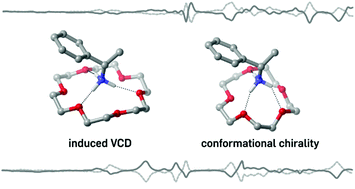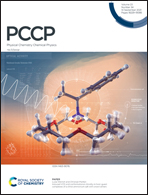Induced VCD and conformational chirality in host–guest complexes of a chiral ammonium salt with crown ethers†
Abstract
The hydrogen bonded complexes of the chiral ammonium salt α-methylbenzyl ammonium chloride (MBA-H+Cl−) and the achiral crown ethers 18c6 and 15c5 serve as model systems to investigate the effect of host–guest complex formation on the conformational preferences of the macrocycles. We demonstrate that the intermolecular interactions result in new VCD signatures, that can be assigned to vibrational modes of the crown ethers. Based on a detailed conformational analysis, we investigate the origin of these signatures and discuss induced VCD (iVCD) and conformational chirality as possible sources of VCD intensity. The macrocycle in the MBA-H+/18c6 complex prefers either an achiral D3d-symmetric conformation, which gives rise to iVCD, or chiral conformations, that feature individual contributions to the VCD spectrum. For the MBA-H+/15c5 complex, the contributions of the macrocycle to the VCD signatures are less pronounced and found to arise solely from conformational chirality. Therefore, analysis of the VCD signatures confirms that the small chiral guest molecule is able to affect the conformational preferences of a macrocyclic host. The study thus demonstrates the suitability of VCD spectroscopy for the characterization of analogous supramolecular host–guest complexes.

- This article is part of the themed collection: 2021 PCCP HOT Articles


 Please wait while we load your content...
Please wait while we load your content...